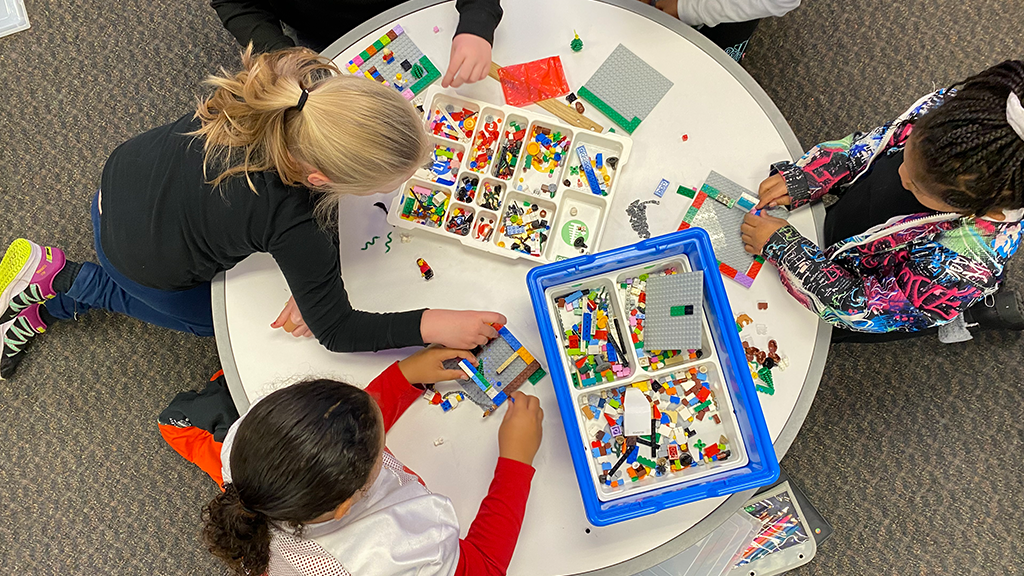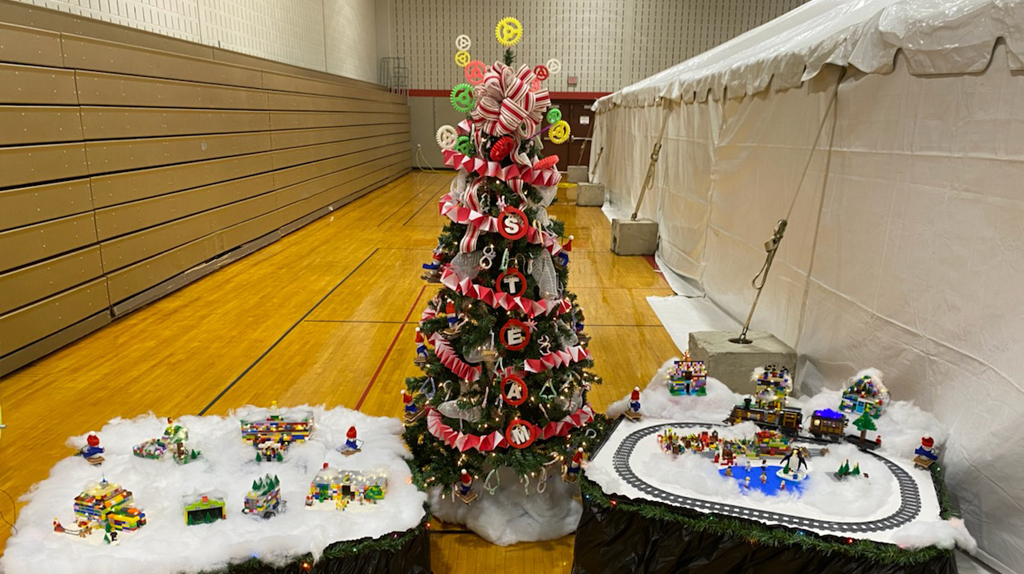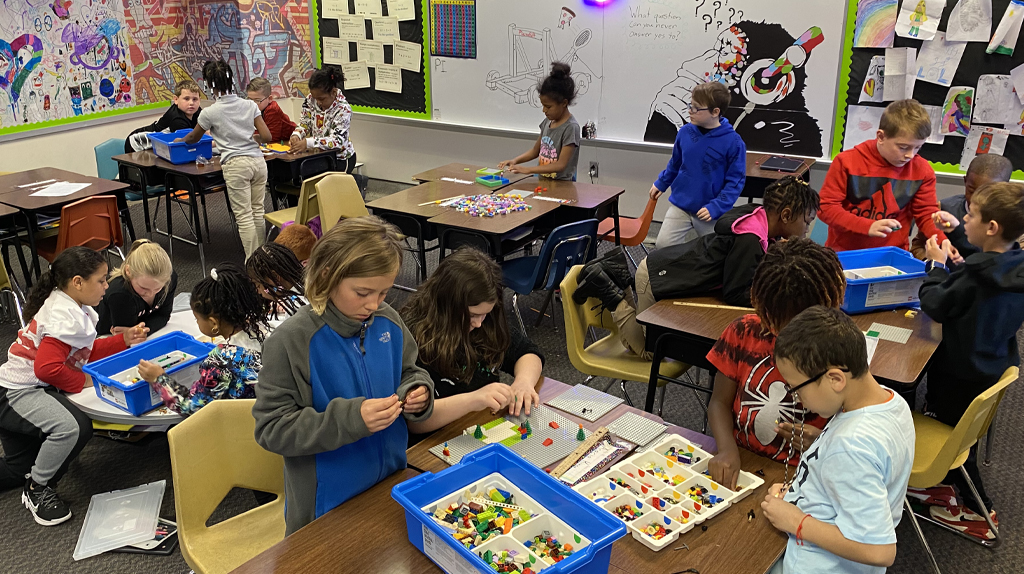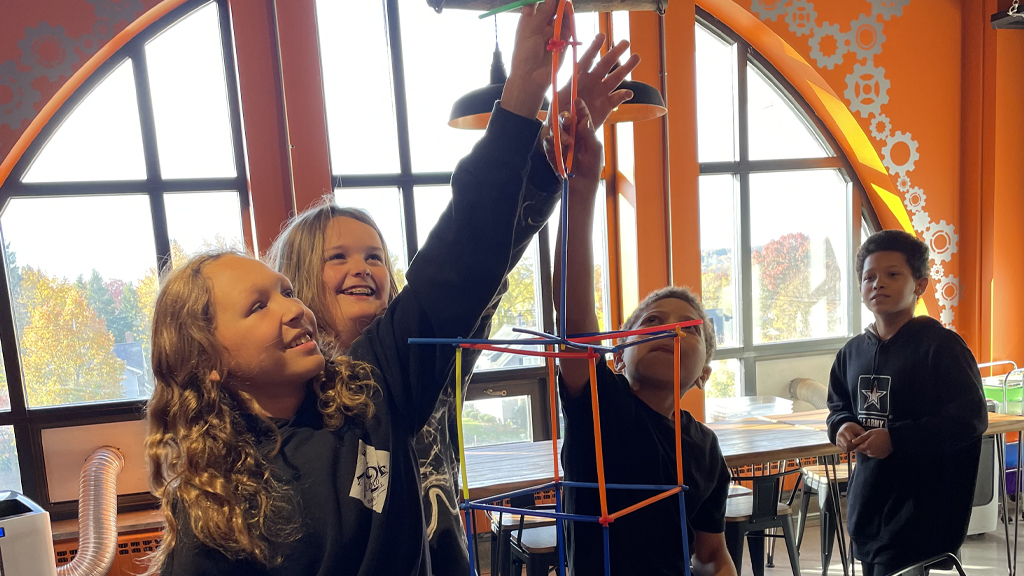
PHOTOS COURTESY OF THE NEW CASTLE AREA SCHOOL DISTRICT
When students returned to classes last fall at George Washington Intermediate School in Pennsylvania’s New Castle Area School District, they wanted to make something to honor a child they never had the chance to meet.
Over several weeks, the third, fourth and fifth graders in this 3,000-student district worked in the Matt’s Maker Space learning room at the school to create a Christmas tree and display that were showcased at a local Festival of Trees in late November. The schoolwide project was in honor of the room’s namesake, Matt Conover, who was 12 when he died from non-Hodgkin’s lymphoma in 2002.
“Developing and building these things—the village under the tree that was entirely illuminated, the train that went around the village—was a chance for their creativity and talents to come alive in that space,” says Pat Cain, the school’s dean of students. “The teacher was so amazed at the thought process of the students and their creativity in solving problems. It was a special project.”

New Castle’s embrace of the “maker movement”—in which the fields of science, technology, engineering, arts, and math (STEAM) are explored through hands-on learning, experimentation, and problem solving—is one way to reengage students in a post-pandemic world. Research shows these types of projects help students understand and apply what they learn. However, those who’ve been engaged in the movement for more than a decade fear that schools are returning to a focus on improving test scores in light of Covid-related losses in achievement.
Nick Steiner, the project director for maker learning at Digital Promise, a nonprofit working to improve learning with technology, says the maker movement is at “an inflection point” as schools look for ways to “get kids ready for the tests again.”
“There’s a sense of panic, and I understand why some educators and community members believe we have to buckle back down and get back to basics, but that’s the wrong approach,” Steiner says. “We’ve all seen how drill-and-kill works, with multiple choice sheets and fill in the blanks. Sometimes that helps you get ready for the test, but it doesn’t stick with students. The question is how we will truly prepare kids for jobs that don’t exist yet but will be there in 10 to 20 years.”
‘Academic, techy, and relevant’
While the concept of “making” is as old as time, the current maker movement started around 2010. Dubbed at one point as the new “industrial revolution,” thanks to the explosion of technology, it has been formally adopted to varying degrees in school districts and communities.
“On one hand, kids who are in FFA [an organization for students interested in careers in the science, business and technology of agriculture] have been doing making forever, and there are weaving practices that are culturally sustainable that have been in place since time began in communities all over the U.S.,” says Erica Halverson, a professor and researcher at the University of Wisconsin-Madison. “The question is how to take practices that we’re already engaged in and connect them to STEM/STEAM practices for further academic learning. Without a robust curriculum to show what the technology is used for, a 3D printer becomes a way to make keychains.”
Diane Brancazio is a former mechanical engineer who also taught engineering, computer science, and general science for 15 years in Belmont, Massachusetts. Now the K-12 maker team leader at the Massachusetts Institute of Technology’s Edgerton Center, Brancazio helps teachers learn how to integrate maker spaces and projects into all types of academic classes.
“When making became part of the education vernacular, teachers thought it would replace engineering, but it really is a gateway to engineering,” Brancazio says. “A maker space is a great way to level the playing field for kids because it gives them access to do this work during the regular school day. They’re more engaged in the academic content. They’re doing more problem solving.”
The best maker projects are “academic, techy, and relevant,” Brancazio says, noting that schools need to “have the space or at least the tools to support” this type of work. In the professional development she supervises, teachers learn they must be facilitators and not instructors.
“The focus is on experiential learning, learning by doing,” she says. “I tell teachers, ‘Don’t let them know they’re learning until it’s too late.’ If kids are having fun, they will embrace learning. You’ll have kids that are not normally very good academically teaching other kids. They will get social capital that they may not get in other areas because they don’t do well on tests or are not the first ones to answer questions in class.”
Halverson agrees. She says the best maker projects focus on “what good teaching and learning looks like rather than the deficits of what kids bring into the classroom.”
“Because kids are behind now in their reading and math skills, there is a temptation to double down on what they’re missing,” she says. “While that may be useful rhetorically, that doubling down doesn’t offer any real mechanism for connecting the student’s world to what they take out from their school experience. Making allows them to connect those two worlds.”
Spaces of innovation
As schools rethink traditional methods to incorporate maker projects, many are doing so in conjunction with remaking their libraries for 21st century learning.
“If you think about it, it’s a large open space in your school, with great access to the reading and research materials for whatever you’re building, constructing or exploring,” says Jennine Cerra, who works at Gaudet Learning Academy in Middletown, Rhode Island. “People don’t think to pair the two places, but maker spaces and libraries go together really well.”

At Thomas Blake Middle School in Medford, Massachusetts, technology integration specialist Diane Horvath has operated a maker space in the library for the past several years. Horvath says her passion is “getting teachers to reinvent, remix or bring other creative aspects” to the same lessons they have taught for years.
“We used to have a wood shop, a metal shop, and a sewing class here, but those don’t exist anymore,” she says. “Making is a way to develop activities that show kids how to go from having an idea on paper and turning it into something they can hold in their hands.”
Most of the projects at Horvath’s school are do-it-yourself lessons that focus less on the technology and more on the innovation.
“Every student should have the same type of experience, and that starts with the materials. We’re not buying a bunch of expensive kits, because that gets expensive when you try to sustain it,” she says. “Instead, we’ve moved more to DIY [do it yourself] with everyday materials such as cardboard. Kids really love to cut cardboard and put it together.”
Cerra teaches a “Library as a Maker” class to students in grades four and five, with a focus on robotics. Her school, located just outside Newport, is funding the program with a grant from the U.S. Department of Defense.
“We have a large population of military children in the building, and the grant is designed to help children of military families do better in science,” says Cerra, who has worked as a librarian for the school for three years.
Students at Cerra’s school first participate in lessons on how robots work, then design their own prototypes on paper before coming together in teams to decide which one to build. Over the course of the year, Cerra sees the students learn how to solve problems and work collaboratively.
“At the beginning of the year, they all want be in charge and don’t want to work as a team, but they learn to communicate and collaborate much better as the year goes on,” Cerra says. “It’s fascinating to watch them correct themselves and each other without me having to step in. My role is more of a facilitator. I show them how the things work and how to access what they need, but the students are the ones who are driving their own learning, which is really cool.”
Mae Craddock, who works at the Community Lab School in Charlottesville, Virginia, says maker learning is well-suited for the library. “I’ve argued from the beginning that this is where it belongs,” says Craddock, the school’s librarian and research support specialist. “Research is the primary function of the library, so when a student comes to us with an idea, we have all the supporting resources to make that idea into a reality.”

Enrollment at Albemarle County Public Schools’ Community Lab School, which has just 200 students in grades six to 12, is based on a lottery system. In grades six to eight, all subjects except math are interdisciplinary, multiage classes that are taught through project-based learning. The same is true for grades nine and 10 in all classes except math and electives, while juniors and seniors are enrolled in the International Baccalaureate program.
“Maker-centered learning is about context, not content,” Principal Chad Ratliff says. “This is what schools should be.”
Post-pandemic collaboration
In 2016, after their last child graduated from high school, Noelle and David Conover were looking for some way to honor the son they had lost 14 years earlier. The principal at Matt’s elementary school in Mt. Lebanon, Pennsylvania, brought up the idea of a maker space and the couple was sold.
In 2017-18, the Conovers donated $175,000 to build and help equip Matt’s Maker Spaces in or next to the libraries of Mt. Lebanon’s seven elementary schools. Over the past four years, with mostly private funds and some donations to their foundation, they have set up 33 of the spaces in schools, libraries, hospitals, and a mental health facility in western Pennsylvania.
Three years ago, the Conovers helped fund the space at George Washington Intermediate School in New Castle after teacher Bill Cook won a contest through the Children’s Museum of Pittsburgh. Due to the pandemic, the Festival of Lights project was the first major opportunity for the district to show what it could do with the space.
Using 3D printers, a vinyl cutter, and other technology tools, third grade students built an illuminated Lego village and train station. The fourth and fifth grade classes made the garland and 3D ornaments for the tree from various materials.
“Virtual learning took away the students’ opportunities to collaborate,” Principal Dave Antuono says. “With this project, every student at every grade level contributed in some way to the finished product. Watching the collaboration in that room, seeing students working together in small groups doing parts of the tree and village was really something to see.”
Tabitha Marino, New Castle’s director of academics and innovation, says helping students with social and emotional learning (SEL) has long been a focus in the district, located about an hour and 10 minutes north of Pittsburgh. She says maker learning and SEL are a great match.
“Coming off the pandemic, where students were home and not interacting with other kids as much as they do in school, this was an opportunity for them to work together as a team,” Marino says. “As we were going through the design process, you could see the students engaging in collaborative problem solving, demonstrating curiosity and open mindedness, taking in other’s perspectives, and developing positive relationships with their peers. These are all competencies of social and emotional learning and that’s huge for us.”
Matt’s parents drove up to New Castle to see the finished product and were “blown away” by the students’ work, Noelle Conover says. It was the type of project her son would have loved.
“Matt was a maker. He was the kid who was constantly building things with Legos. He loved to tinker and make things. It was just natural for him,” she says. “Seeing what these kids have done, what they made, was just wonderful. It was a special way to honor our son.”
_________________________________________________________________________________________________________________
Glenn Cook (glenncook117@gmail.com), a contributing editor to American School Board Journal, is a freelance writer and photographer in Northern Virginia.

Share this content